National Training: BSBHRM513 Manage Workforce Planning Assessment
VerifiedAdded on 2022/12/29
|39
|9018
|28
Homework Assignment
AI Summary
This document serves as a comprehensive assessment guide for the BSBHRM513 Manage Workforce Planning unit offered by National Training. It details the assessment process, including version control, copyright information, and a disclaimer. The guide provides instructions, assessment activities, and evaluation criteria for various assessments, including written questions and case studies. It covers topics such as understanding assessment terminology, plagiarism guidelines, referencing materials, and the submission and grading process. The guide also includes information on understanding results, resubmissions, and appeals. The assessment includes elements of labour market analysis, and case studies. Students are provided with resources and support materials to aid in their learning and assessment completion. The guide also includes information on word counts, plagiarism, referencing, submission of assessments, and grading. The assessment results, resubmissions, and appeal processes are explained, ensuring students understand the requirements and procedures.

Paraphrase This Document
Need a fresh take? Get an instant paraphrase of this document with our AI Paraphraser
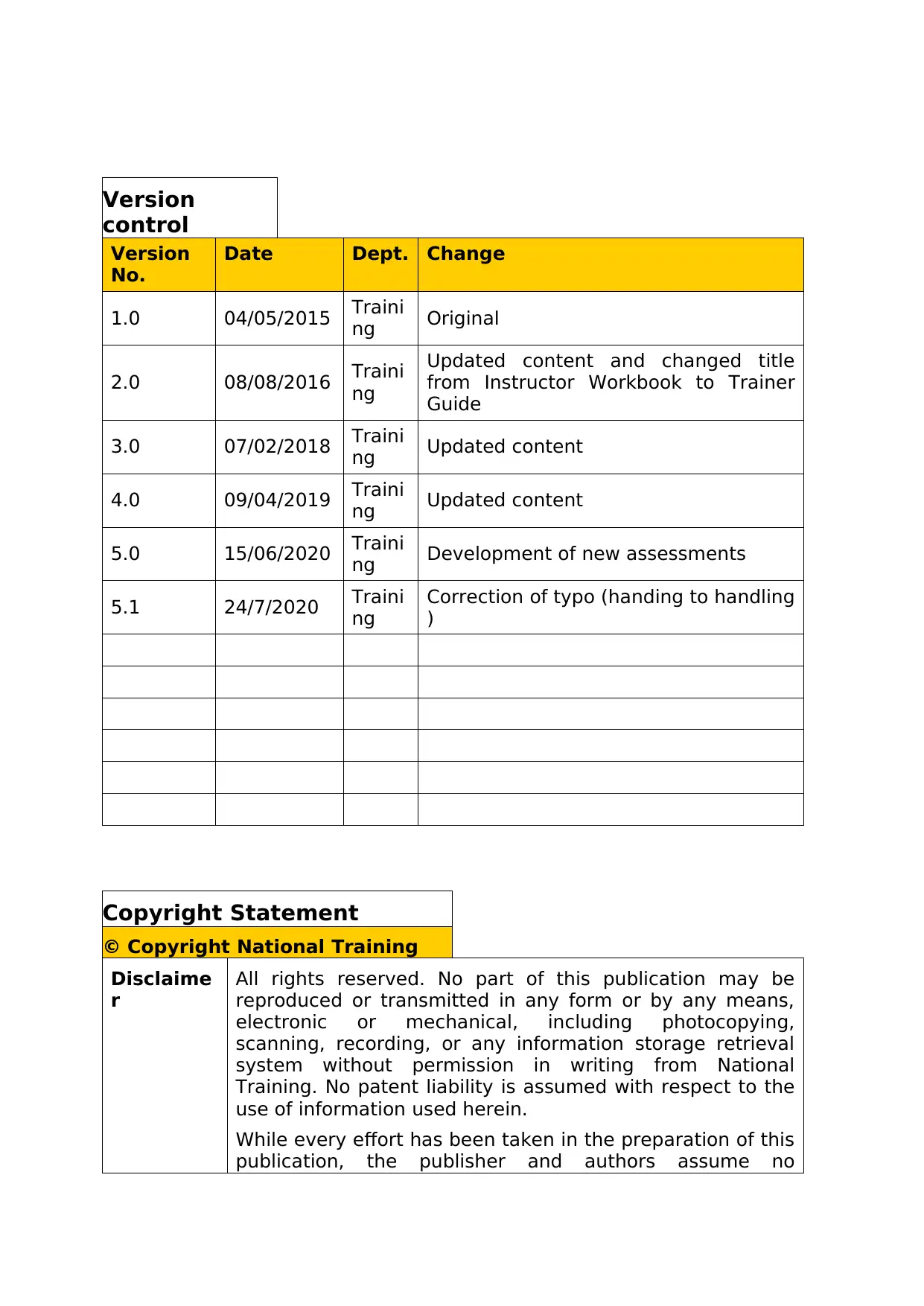
Version
control
Version
No.
Date Dept. Change
1.0 04/05/2015 Traini
ng Original
2.0 08/08/2016 Traini
ng
Updated content and changed title
from Instructor Workbook to Trainer
Guide
3.0 07/02/2018 Traini
ng Updated content
4.0 09/04/2019 Traini
ng Updated content
5.0 15/06/2020 Traini
ng Development of new assessments
5.1 24/7/2020 Traini
ng
Correction of typo (handing to handling
)
Copyright Statement
© Copyright National Training
Disclaime
r
All rights reserved. No part of this publication may be
reproduced or transmitted in any form or by any means,
electronic or mechanical, including photocopying,
scanning, recording, or any information storage retrieval
system without permission in writing from National
Training. No patent liability is assumed with respect to the
use of information used herein.
While every effort has been taken in the preparation of this
publication, the publisher and authors assume no
control
Version
No.
Date Dept. Change
1.0 04/05/2015 Traini
ng Original
2.0 08/08/2016 Traini
ng
Updated content and changed title
from Instructor Workbook to Trainer
Guide
3.0 07/02/2018 Traini
ng Updated content
4.0 09/04/2019 Traini
ng Updated content
5.0 15/06/2020 Traini
ng Development of new assessments
5.1 24/7/2020 Traini
ng
Correction of typo (handing to handling
)
Copyright Statement
© Copyright National Training
Disclaime
r
All rights reserved. No part of this publication may be
reproduced or transmitted in any form or by any means,
electronic or mechanical, including photocopying,
scanning, recording, or any information storage retrieval
system without permission in writing from National
Training. No patent liability is assumed with respect to the
use of information used herein.
While every effort has been taken in the preparation of this
publication, the publisher and authors assume no
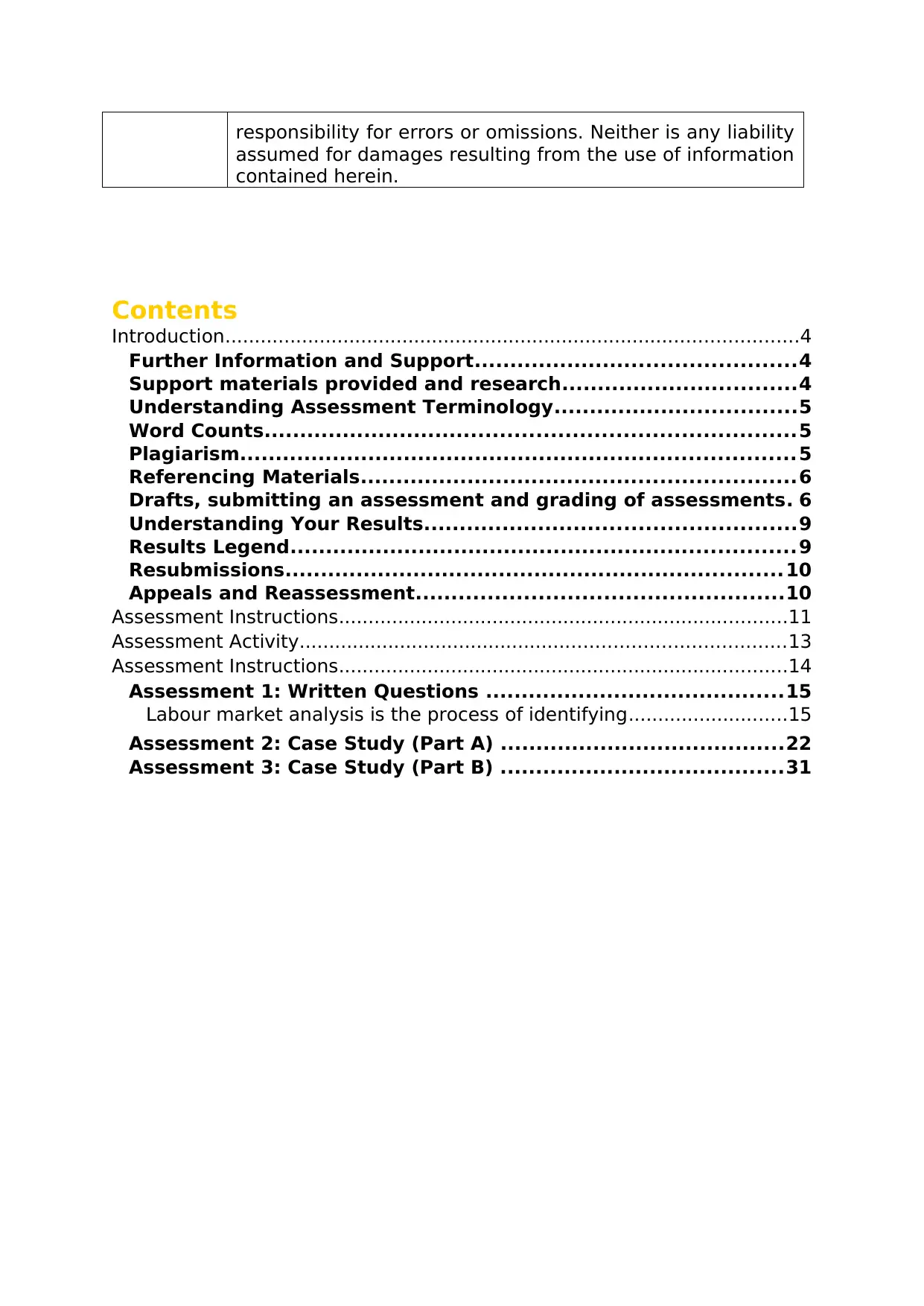
responsibility for errors or omissions. Neither is any liability
assumed for damages resulting from the use of information
contained herein.
Contents
Introduction.................................................................................................4
Further Information and Support.............................................4
Support materials provided and research.................................4
Understanding Assessment Terminology..................................5
Word Counts..........................................................................5
Plagiarism.............................................................................. 5
Referencing Materials.............................................................6
Drafts, submitting an assessment and grading of assessments. 6
Understanding Your Results....................................................9
Results Legend.......................................................................9
Resubmissions......................................................................10
Appeals and Reassessment...................................................10
Assessment Instructions............................................................................11
Assessment Activity..................................................................................13
Assessment Instructions............................................................................14
Assessment 1: Written Questions ..........................................15
Labour market analysis is the process of identifying...........................15
Assessment 2: Case Study (Part A) ........................................22
Assessment 3: Case Study (Part B) ........................................31
assumed for damages resulting from the use of information
contained herein.
Contents
Introduction.................................................................................................4
Further Information and Support.............................................4
Support materials provided and research.................................4
Understanding Assessment Terminology..................................5
Word Counts..........................................................................5
Plagiarism.............................................................................. 5
Referencing Materials.............................................................6
Drafts, submitting an assessment and grading of assessments. 6
Understanding Your Results....................................................9
Results Legend.......................................................................9
Resubmissions......................................................................10
Appeals and Reassessment...................................................10
Assessment Instructions............................................................................11
Assessment Activity..................................................................................13
Assessment Instructions............................................................................14
Assessment 1: Written Questions ..........................................15
Labour market analysis is the process of identifying...........................15
Assessment 2: Case Study (Part A) ........................................22
Assessment 3: Case Study (Part B) ........................................31
⊘ This is a preview!⊘
Do you want full access?
Subscribe today to unlock all pages.

Trusted by 1+ million students worldwide
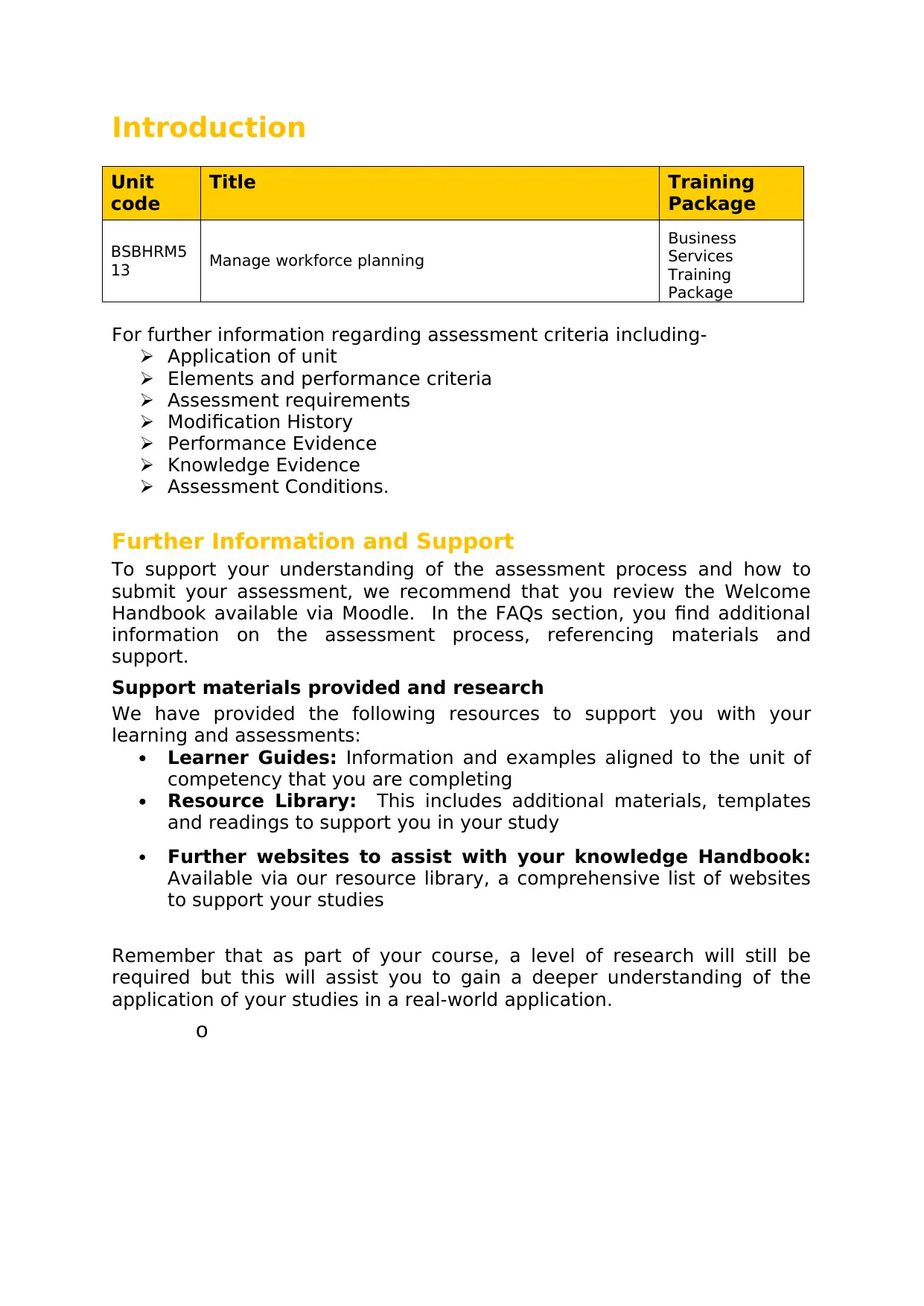
Introduction
Unit
code
Title Training
Package
BSBHRM5
13 Manage workforce planning
Business
Services
Training
Package
For further information regarding assessment criteria including-
Application of unit
Elements and performance criteria
Assessment requirements
Modification History
Performance Evidence
Knowledge Evidence
Assessment Conditions.
Further Information and Support
To support your understanding of the assessment process and how to
submit your assessment, we recommend that you review the Welcome
Handbook available via Moodle. In the FAQs section, you find additional
information on the assessment process, referencing materials and
support.
Support materials provided and research
We have provided the following resources to support you with your
learning and assessments:
Learner Guides: Information and examples aligned to the unit of
competency that you are completing
Resource Library: This includes additional materials, templates
and readings to support you in your study
Further websites to assist with your knowledge Handbook:
Available via our resource library, a comprehensive list of websites
to support your studies
Remember that as part of your course, a level of research will still be
required but this will assist you to gain a deeper understanding of the
application of your studies in a real-world application.
o
Unit
code
Title Training
Package
BSBHRM5
13 Manage workforce planning
Business
Services
Training
Package
For further information regarding assessment criteria including-
Application of unit
Elements and performance criteria
Assessment requirements
Modification History
Performance Evidence
Knowledge Evidence
Assessment Conditions.
Further Information and Support
To support your understanding of the assessment process and how to
submit your assessment, we recommend that you review the Welcome
Handbook available via Moodle. In the FAQs section, you find additional
information on the assessment process, referencing materials and
support.
Support materials provided and research
We have provided the following resources to support you with your
learning and assessments:
Learner Guides: Information and examples aligned to the unit of
competency that you are completing
Resource Library: This includes additional materials, templates
and readings to support you in your study
Further websites to assist with your knowledge Handbook:
Available via our resource library, a comprehensive list of websites
to support your studies
Remember that as part of your course, a level of research will still be
required but this will assist you to gain a deeper understanding of the
application of your studies in a real-world application.
o
Paraphrase This Document
Need a fresh take? Get an instant paraphrase of this document with our AI Paraphraser
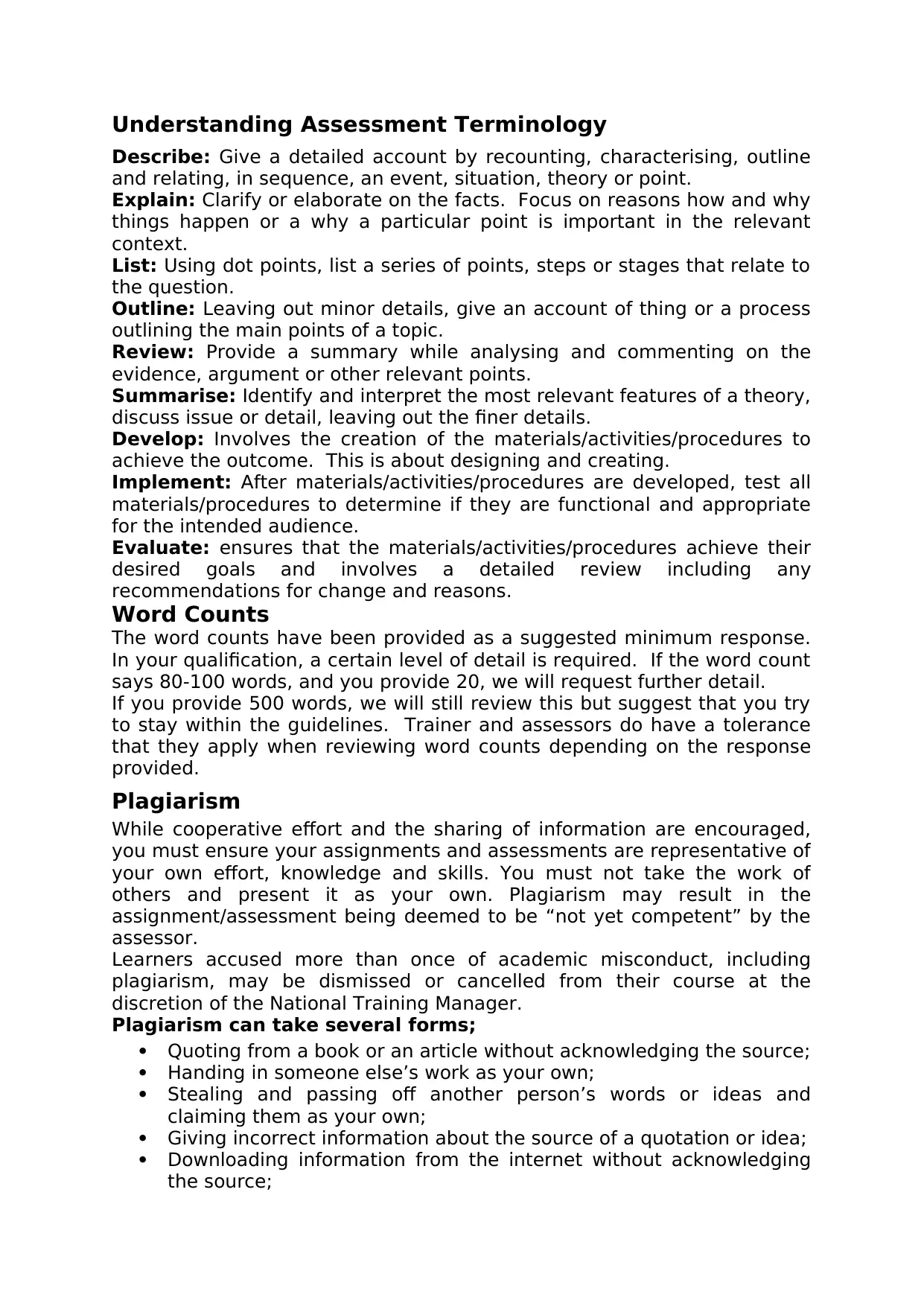
Understanding Assessment Terminology
Describe: Give a detailed account by recounting, characterising, outline
and relating, in sequence, an event, situation, theory or point.
Explain: Clarify or elaborate on the facts. Focus on reasons how and why
things happen or a why a particular point is important in the relevant
context.
List: Using dot points, list a series of points, steps or stages that relate to
the question.
Outline: Leaving out minor details, give an account of thing or a process
outlining the main points of a topic.
Review: Provide a summary while analysing and commenting on the
evidence, argument or other relevant points.
Summarise: Identify and interpret the most relevant features of a theory,
discuss issue or detail, leaving out the finer details.
Develop: Involves the creation of the materials/activities/procedures to
achieve the outcome. This is about designing and creating.
Implement: After materials/activities/procedures are developed, test all
materials/procedures to determine if they are functional and appropriate
for the intended audience.
Evaluate: ensures that the materials/activities/procedures achieve their
desired goals and involves a detailed review including any
recommendations for change and reasons.
Word Counts
The word counts have been provided as a suggested minimum response.
In your qualification, a certain level of detail is required. If the word count
says 80-100 words, and you provide 20, we will request further detail.
If you provide 500 words, we will still review this but suggest that you try
to stay within the guidelines. Trainer and assessors do have a tolerance
that they apply when reviewing word counts depending on the response
provided.
Plagiarism
While cooperative effort and the sharing of information are encouraged,
you must ensure your assignments and assessments are representative of
your own effort, knowledge and skills. You must not take the work of
others and present it as your own. Plagiarism may result in the
assignment/assessment being deemed to be “not yet competent” by the
assessor.
Learners accused more than once of academic misconduct, including
plagiarism, may be dismissed or cancelled from their course at the
discretion of the National Training Manager.
Plagiarism can take several forms;
Quoting from a book or an article without acknowledging the source;
Handing in someone else’s work as your own;
Stealing and passing off another person’s words or ideas and
claiming them as your own;
Giving incorrect information about the source of a quotation or idea;
Downloading information from the internet without acknowledging
the source;
Describe: Give a detailed account by recounting, characterising, outline
and relating, in sequence, an event, situation, theory or point.
Explain: Clarify or elaborate on the facts. Focus on reasons how and why
things happen or a why a particular point is important in the relevant
context.
List: Using dot points, list a series of points, steps or stages that relate to
the question.
Outline: Leaving out minor details, give an account of thing or a process
outlining the main points of a topic.
Review: Provide a summary while analysing and commenting on the
evidence, argument or other relevant points.
Summarise: Identify and interpret the most relevant features of a theory,
discuss issue or detail, leaving out the finer details.
Develop: Involves the creation of the materials/activities/procedures to
achieve the outcome. This is about designing and creating.
Implement: After materials/activities/procedures are developed, test all
materials/procedures to determine if they are functional and appropriate
for the intended audience.
Evaluate: ensures that the materials/activities/procedures achieve their
desired goals and involves a detailed review including any
recommendations for change and reasons.
Word Counts
The word counts have been provided as a suggested minimum response.
In your qualification, a certain level of detail is required. If the word count
says 80-100 words, and you provide 20, we will request further detail.
If you provide 500 words, we will still review this but suggest that you try
to stay within the guidelines. Trainer and assessors do have a tolerance
that they apply when reviewing word counts depending on the response
provided.
Plagiarism
While cooperative effort and the sharing of information are encouraged,
you must ensure your assignments and assessments are representative of
your own effort, knowledge and skills. You must not take the work of
others and present it as your own. Plagiarism may result in the
assignment/assessment being deemed to be “not yet competent” by the
assessor.
Learners accused more than once of academic misconduct, including
plagiarism, may be dismissed or cancelled from their course at the
discretion of the National Training Manager.
Plagiarism can take several forms;
Quoting from a book or an article without acknowledging the source;
Handing in someone else’s work as your own;
Stealing and passing off another person’s words or ideas and
claiming them as your own;
Giving incorrect information about the source of a quotation or idea;
Downloading information from the internet without acknowledging
the source;
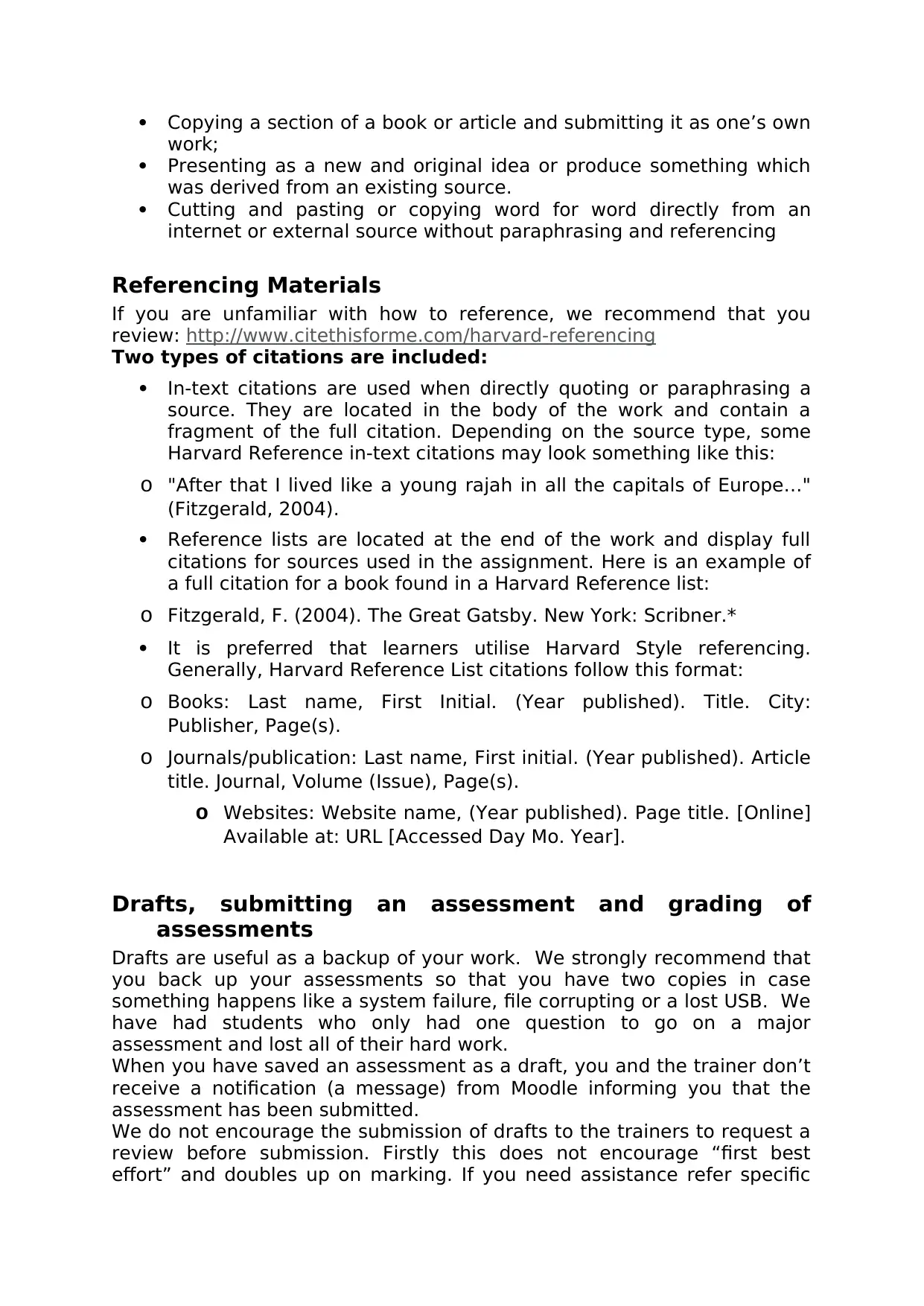
Copying a section of a book or article and submitting it as one’s own
work;
Presenting as a new and original idea or produce something which
was derived from an existing source.
Cutting and pasting or copying word for word directly from an
internet or external source without paraphrasing and referencing
Referencing Materials
If you are unfamiliar with how to reference, we recommend that you
review: http://www.citethisforme.com/harvard-referencing
Two types of citations are included:
In-text citations are used when directly quoting or paraphrasing a
source. They are located in the body of the work and contain a
fragment of the full citation. Depending on the source type, some
Harvard Reference in-text citations may look something like this:
o "After that I lived like a young rajah in all the capitals of Europe…"
(Fitzgerald, 2004).
Reference lists are located at the end of the work and display full
citations for sources used in the assignment. Here is an example of
a full citation for a book found in a Harvard Reference list:
o Fitzgerald, F. (2004). The Great Gatsby. New York: Scribner.*
It is preferred that learners utilise Harvard Style referencing.
Generally, Harvard Reference List citations follow this format:
o Books: Last name, First Initial. (Year published). Title. City:
Publisher, Page(s).
o Journals/publication: Last name, First initial. (Year published). Article
title. Journal, Volume (Issue), Page(s).
o Websites: Website name, (Year published). Page title. [Online]
Available at: URL [Accessed Day Mo. Year].
Drafts, submitting an assessment and grading of
assessments
Drafts are useful as a backup of your work. We strongly recommend that
you back up your assessments so that you have two copies in case
something happens like a system failure, file corrupting or a lost USB. We
have had students who only had one question to go on a major
assessment and lost all of their hard work.
When you have saved an assessment as a draft, you and the trainer don’t
receive a notification (a message) from Moodle informing you that the
assessment has been submitted.
We do not encourage the submission of drafts to the trainers to request a
review before submission. Firstly this does not encourage “first best
effort” and doubles up on marking. If you need assistance refer specific
work;
Presenting as a new and original idea or produce something which
was derived from an existing source.
Cutting and pasting or copying word for word directly from an
internet or external source without paraphrasing and referencing
Referencing Materials
If you are unfamiliar with how to reference, we recommend that you
review: http://www.citethisforme.com/harvard-referencing
Two types of citations are included:
In-text citations are used when directly quoting or paraphrasing a
source. They are located in the body of the work and contain a
fragment of the full citation. Depending on the source type, some
Harvard Reference in-text citations may look something like this:
o "After that I lived like a young rajah in all the capitals of Europe…"
(Fitzgerald, 2004).
Reference lists are located at the end of the work and display full
citations for sources used in the assignment. Here is an example of
a full citation for a book found in a Harvard Reference list:
o Fitzgerald, F. (2004). The Great Gatsby. New York: Scribner.*
It is preferred that learners utilise Harvard Style referencing.
Generally, Harvard Reference List citations follow this format:
o Books: Last name, First Initial. (Year published). Title. City:
Publisher, Page(s).
o Journals/publication: Last name, First initial. (Year published). Article
title. Journal, Volume (Issue), Page(s).
o Websites: Website name, (Year published). Page title. [Online]
Available at: URL [Accessed Day Mo. Year].
Drafts, submitting an assessment and grading of
assessments
Drafts are useful as a backup of your work. We strongly recommend that
you back up your assessments so that you have two copies in case
something happens like a system failure, file corrupting or a lost USB. We
have had students who only had one question to go on a major
assessment and lost all of their hard work.
When you have saved an assessment as a draft, you and the trainer don’t
receive a notification (a message) from Moodle informing you that the
assessment has been submitted.
We do not encourage the submission of drafts to the trainers to request a
review before submission. Firstly this does not encourage “first best
effort” and doubles up on marking. If you need assistance refer specific
⊘ This is a preview!⊘
Do you want full access?
Subscribe today to unlock all pages.

Trusted by 1+ million students worldwide

questions to your trainer on the areas that you require direction or
assistance.
assistance.
Paraphrase This Document
Need a fresh take? Get an instant paraphrase of this document with our AI Paraphraser
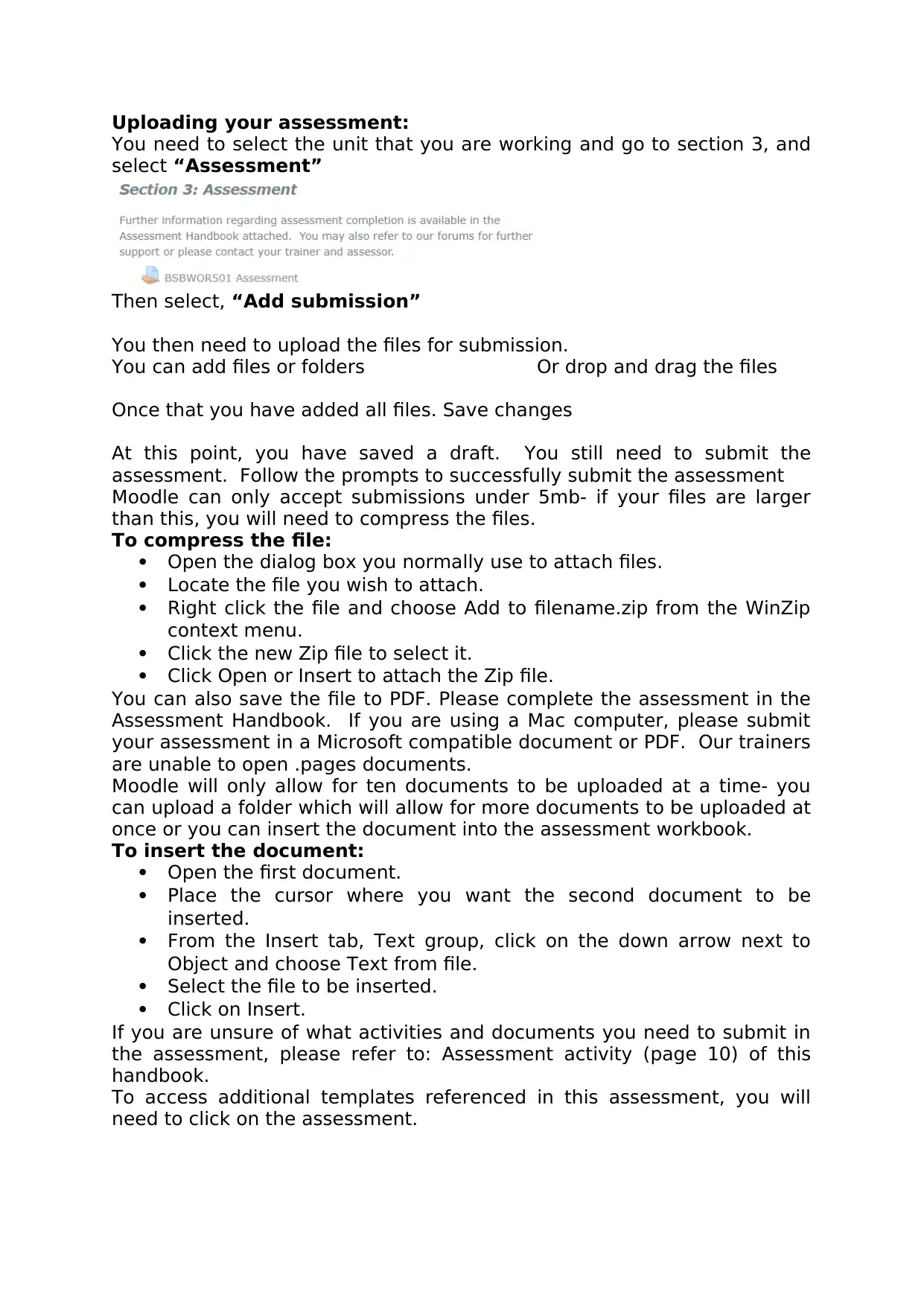
Uploading your assessment:
You need to select the unit that you are working and go to section 3, and
select “Assessment”
Then select, “Add submission”
You then need to upload the files for submission.
You can add files or folders Or drop and drag the files
Once that you have added all files. Save changes
At this point, you have saved a draft. You still need to submit the
assessment. Follow the prompts to successfully submit the assessment
Moodle can only accept submissions under 5mb- if your files are larger
than this, you will need to compress the files.
To compress the file:
Open the dialog box you normally use to attach files.
Locate the file you wish to attach.
Right click the file and choose Add to filename.zip from the WinZip
context menu.
Click the new Zip file to select it.
Click Open or Insert to attach the Zip file.
You can also save the file to PDF. Please complete the assessment in the
Assessment Handbook. If you are using a Mac computer, please submit
your assessment in a Microsoft compatible document or PDF. Our trainers
are unable to open .pages documents.
Moodle will only allow for ten documents to be uploaded at a time- you
can upload a folder which will allow for more documents to be uploaded at
once or you can insert the document into the assessment workbook.
To insert the document:
Open the first document.
Place the cursor where you want the second document to be
inserted.
From the Insert tab, Text group, click on the down arrow next to
Object and choose Text from file.
Select the file to be inserted.
Click on Insert.
If you are unsure of what activities and documents you need to submit in
the assessment, please refer to: Assessment activity (page 10) of this
handbook.
To access additional templates referenced in this assessment, you will
need to click on the assessment.
You need to select the unit that you are working and go to section 3, and
select “Assessment”
Then select, “Add submission”
You then need to upload the files for submission.
You can add files or folders Or drop and drag the files
Once that you have added all files. Save changes
At this point, you have saved a draft. You still need to submit the
assessment. Follow the prompts to successfully submit the assessment
Moodle can only accept submissions under 5mb- if your files are larger
than this, you will need to compress the files.
To compress the file:
Open the dialog box you normally use to attach files.
Locate the file you wish to attach.
Right click the file and choose Add to filename.zip from the WinZip
context menu.
Click the new Zip file to select it.
Click Open or Insert to attach the Zip file.
You can also save the file to PDF. Please complete the assessment in the
Assessment Handbook. If you are using a Mac computer, please submit
your assessment in a Microsoft compatible document or PDF. Our trainers
are unable to open .pages documents.
Moodle will only allow for ten documents to be uploaded at a time- you
can upload a folder which will allow for more documents to be uploaded at
once or you can insert the document into the assessment workbook.
To insert the document:
Open the first document.
Place the cursor where you want the second document to be
inserted.
From the Insert tab, Text group, click on the down arrow next to
Object and choose Text from file.
Select the file to be inserted.
Click on Insert.
If you are unsure of what activities and documents you need to submit in
the assessment, please refer to: Assessment activity (page 10) of this
handbook.
To access additional templates referenced in this assessment, you will
need to click on the assessment.
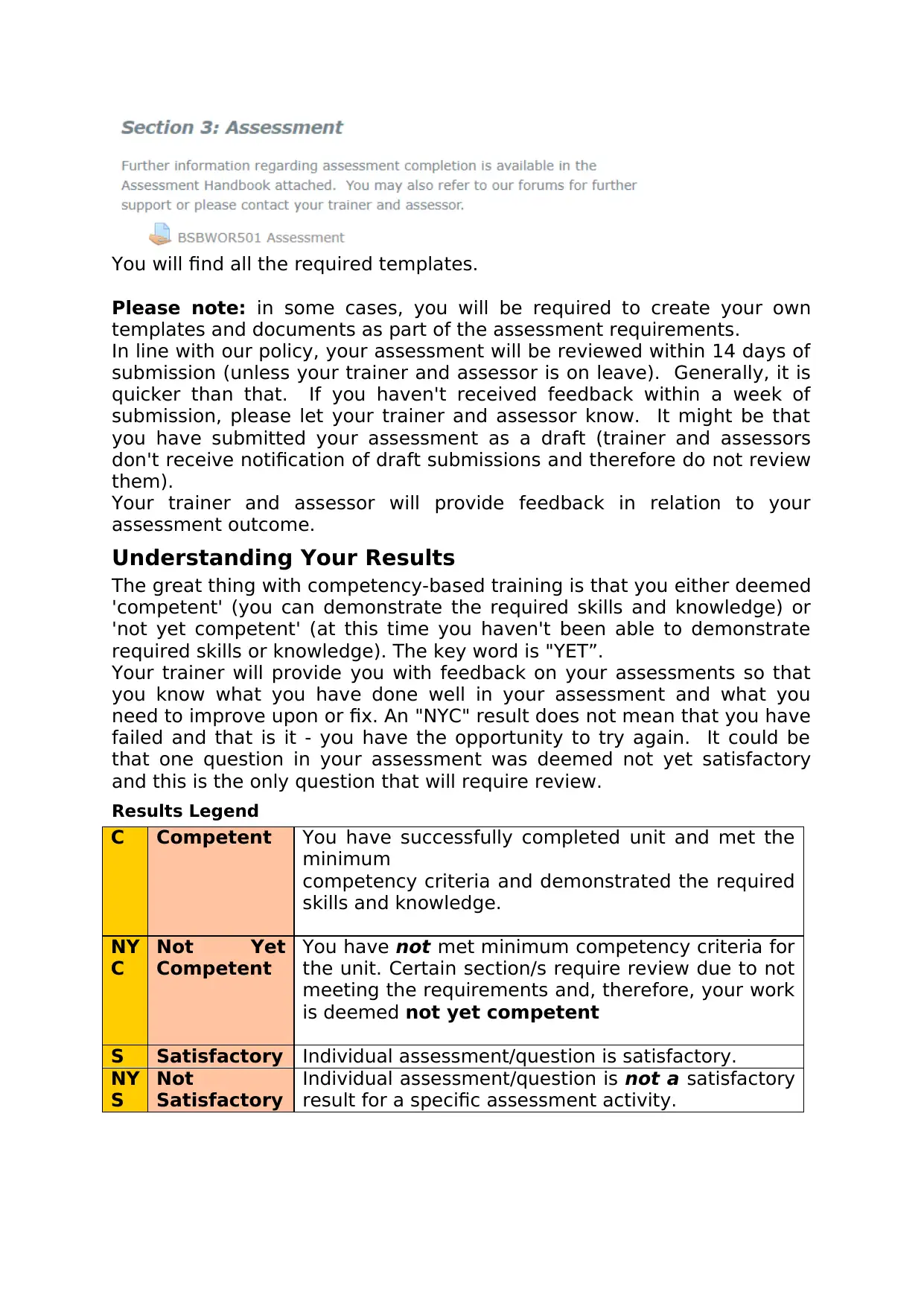
You will find all the required templates.
Please note: in some cases, you will be required to create your own
templates and documents as part of the assessment requirements.
In line with our policy, your assessment will be reviewed within 14 days of
submission (unless your trainer and assessor is on leave). Generally, it is
quicker than that. If you haven't received feedback within a week of
submission, please let your trainer and assessor know. It might be that
you have submitted your assessment as a draft (trainer and assessors
don't receive notification of draft submissions and therefore do not review
them).
Your trainer and assessor will provide feedback in relation to your
assessment outcome.
Understanding Your Results
The great thing with competency-based training is that you either deemed
'competent' (you can demonstrate the required skills and knowledge) or
'not yet competent' (at this time you haven't been able to demonstrate
required skills or knowledge). The key word is "YET”.
Your trainer will provide you with feedback on your assessments so that
you know what you have done well in your assessment and what you
need to improve upon or fix. An "NYC" result does not mean that you have
failed and that is it - you have the opportunity to try again. It could be
that one question in your assessment was deemed not yet satisfactory
and this is the only question that will require review.
Results Legend
C Competent You have successfully completed unit and met the
minimum
competency criteria and demonstrated the required
skills and knowledge.
NY
C
Not Yet
Competent
You have not met minimum competency criteria for
the unit. Certain section/s require review due to not
meeting the requirements and, therefore, your work
is deemed not yet competent
S Satisfactory Individual assessment/question is satisfactory.
NY
S
Not
Satisfactory
Individual assessment/question is not a satisfactory
result for a specific assessment activity.
Please note: in some cases, you will be required to create your own
templates and documents as part of the assessment requirements.
In line with our policy, your assessment will be reviewed within 14 days of
submission (unless your trainer and assessor is on leave). Generally, it is
quicker than that. If you haven't received feedback within a week of
submission, please let your trainer and assessor know. It might be that
you have submitted your assessment as a draft (trainer and assessors
don't receive notification of draft submissions and therefore do not review
them).
Your trainer and assessor will provide feedback in relation to your
assessment outcome.
Understanding Your Results
The great thing with competency-based training is that you either deemed
'competent' (you can demonstrate the required skills and knowledge) or
'not yet competent' (at this time you haven't been able to demonstrate
required skills or knowledge). The key word is "YET”.
Your trainer will provide you with feedback on your assessments so that
you know what you have done well in your assessment and what you
need to improve upon or fix. An "NYC" result does not mean that you have
failed and that is it - you have the opportunity to try again. It could be
that one question in your assessment was deemed not yet satisfactory
and this is the only question that will require review.
Results Legend
C Competent You have successfully completed unit and met the
minimum
competency criteria and demonstrated the required
skills and knowledge.
NY
C
Not Yet
Competent
You have not met minimum competency criteria for
the unit. Certain section/s require review due to not
meeting the requirements and, therefore, your work
is deemed not yet competent
S Satisfactory Individual assessment/question is satisfactory.
NY
S
Not
Satisfactory
Individual assessment/question is not a satisfactory
result for a specific assessment activity.
⊘ This is a preview!⊘
Do you want full access?
Subscribe today to unlock all pages.

Trusted by 1+ million students worldwide
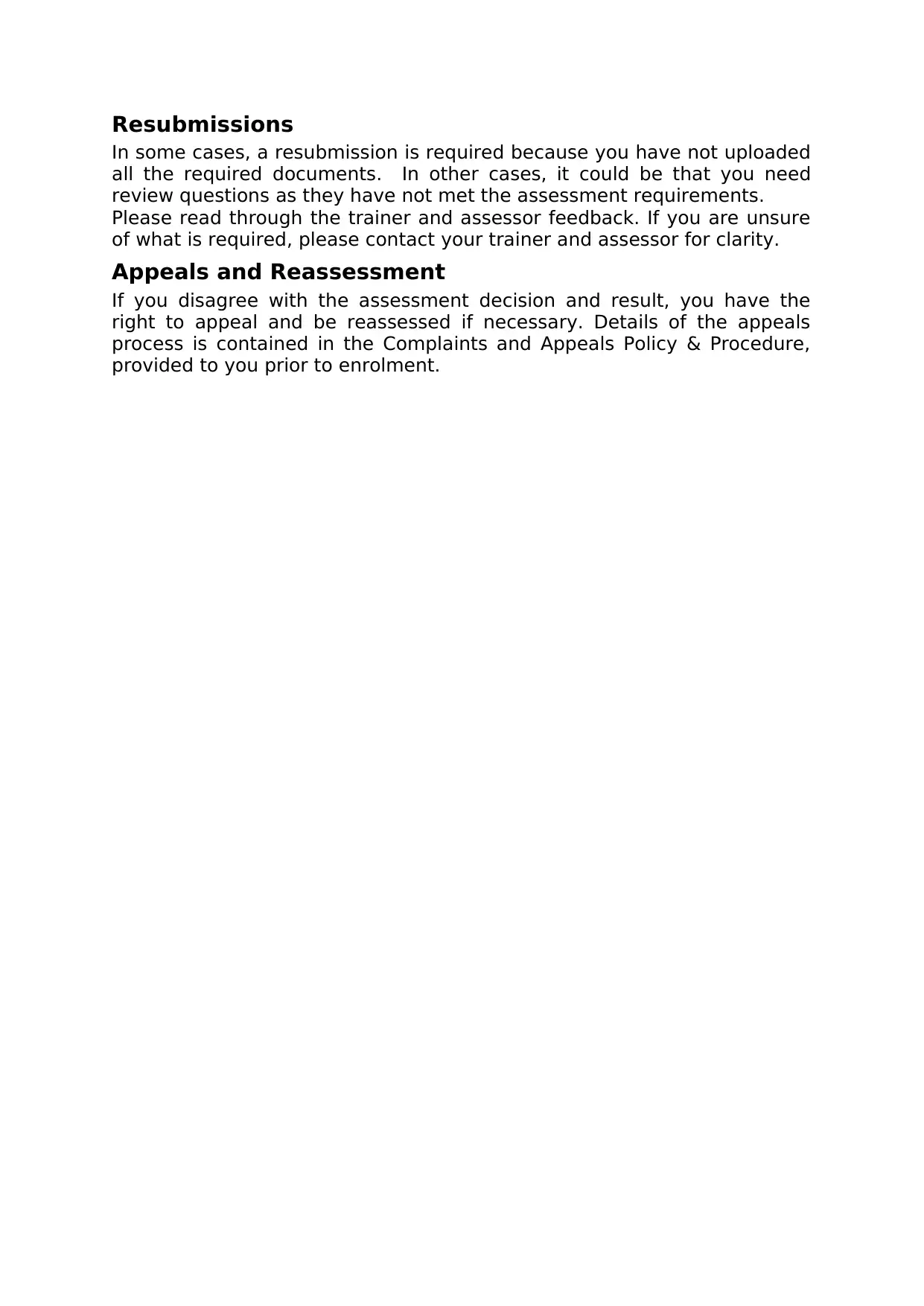
Resubmissions
In some cases, a resubmission is required because you have not uploaded
all the required documents. In other cases, it could be that you need
review questions as they have not met the assessment requirements.
Please read through the trainer and assessor feedback. If you are unsure
of what is required, please contact your trainer and assessor for clarity.
Appeals and Reassessment
If you disagree with the assessment decision and result, you have the
right to appeal and be reassessed if necessary. Details of the appeals
process is contained in the Complaints and Appeals Policy & Procedure,
provided to you prior to enrolment.
In some cases, a resubmission is required because you have not uploaded
all the required documents. In other cases, it could be that you need
review questions as they have not met the assessment requirements.
Please read through the trainer and assessor feedback. If you are unsure
of what is required, please contact your trainer and assessor for clarity.
Appeals and Reassessment
If you disagree with the assessment decision and result, you have the
right to appeal and be reassessed if necessary. Details of the appeals
process is contained in the Complaints and Appeals Policy & Procedure,
provided to you prior to enrolment.
Paraphrase This Document
Need a fresh take? Get an instant paraphrase of this document with our AI Paraphraser
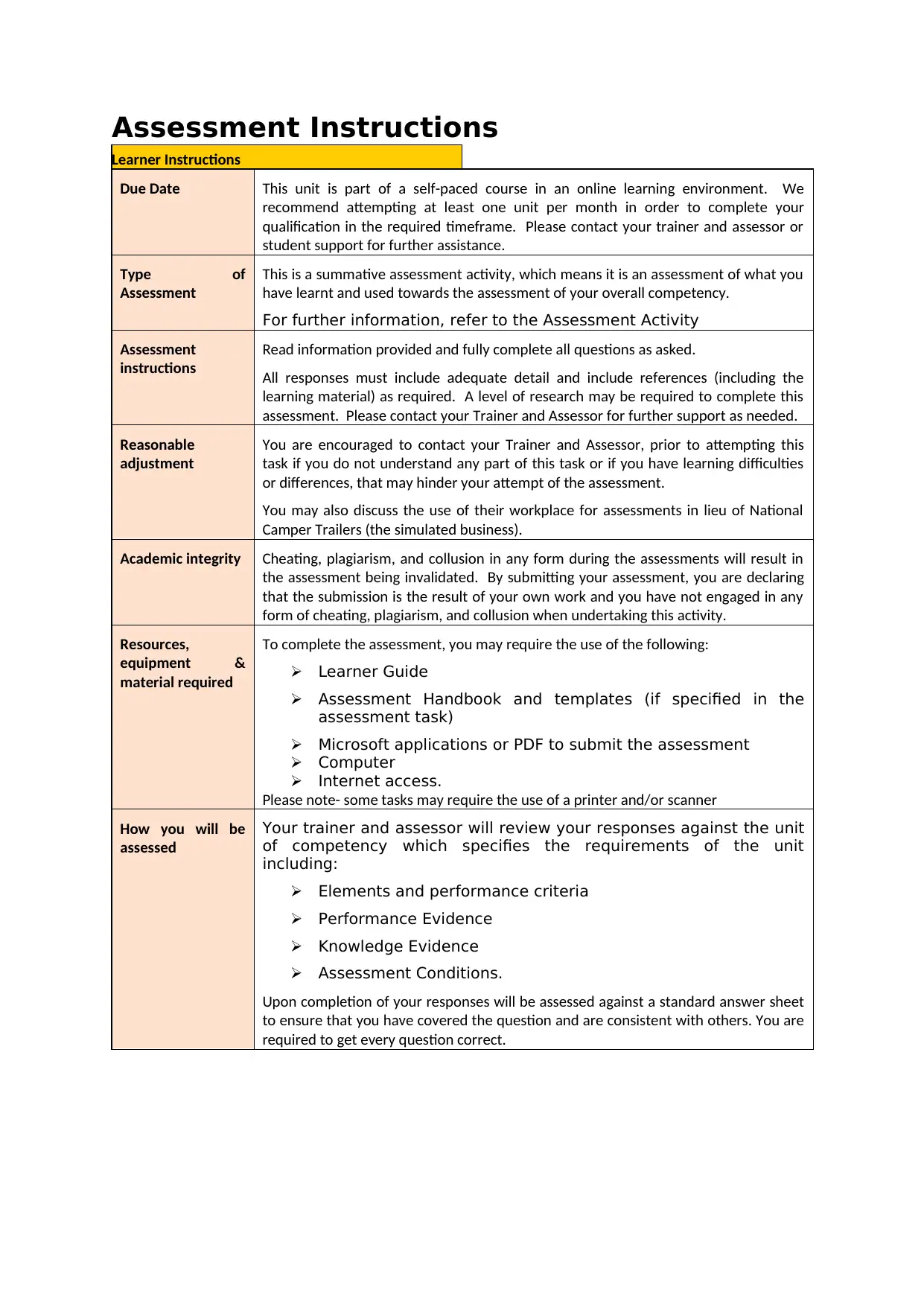
Assessment Instructions
Learner Instructions
Due Date This unit is part of a self-paced course in an online learning environment. We
recommend attempting at least one unit per month in order to complete your
qualification in the required timeframe. Please contact your trainer and assessor or
student support for further assistance.
Type of
Assessment
This is a summative assessment activity, which means it is an assessment of what you
have learnt and used towards the assessment of your overall competency.
For further information, refer to the Assessment Activity
Assessment
instructions
Read information provided and fully complete all questions as asked.
All responses must include adequate detail and include references (including the
learning material) as required. A level of research may be required to complete this
assessment. Please contact your Trainer and Assessor for further support as needed.
Reasonable
adjustment
You are encouraged to contact your Trainer and Assessor, prior to attempting this
task if you do not understand any part of this task or if you have learning difficulties
or differences, that may hinder your attempt of the assessment.
You may also discuss the use of their workplace for assessments in lieu of National
Camper Trailers (the simulated business).
Academic integrity Cheating, plagiarism, and collusion in any form during the assessments will result in
the assessment being invalidated. By submitting your assessment, you are declaring
that the submission is the result of your own work and you have not engaged in any
form of cheating, plagiarism, and collusion when undertaking this activity.
Resources,
equipment &
material required
To complete the assessment, you may require the use of the following:
Learner Guide
Assessment Handbook and templates (if specified in the
assessment task)
Microsoft applications or PDF to submit the assessment
Computer
Internet access.
Please note- some tasks may require the use of a printer and/or scanner
How you will be
assessed
Your trainer and assessor will review your responses against the unit
of competency which specifies the requirements of the unit
including:
Elements and performance criteria
Performance Evidence
Knowledge Evidence
Assessment Conditions.
Upon completion of your responses will be assessed against a standard answer sheet
to ensure that you have covered the question and are consistent with others. You are
required to get every question correct.
Learner Instructions
Due Date This unit is part of a self-paced course in an online learning environment. We
recommend attempting at least one unit per month in order to complete your
qualification in the required timeframe. Please contact your trainer and assessor or
student support for further assistance.
Type of
Assessment
This is a summative assessment activity, which means it is an assessment of what you
have learnt and used towards the assessment of your overall competency.
For further information, refer to the Assessment Activity
Assessment
instructions
Read information provided and fully complete all questions as asked.
All responses must include adequate detail and include references (including the
learning material) as required. A level of research may be required to complete this
assessment. Please contact your Trainer and Assessor for further support as needed.
Reasonable
adjustment
You are encouraged to contact your Trainer and Assessor, prior to attempting this
task if you do not understand any part of this task or if you have learning difficulties
or differences, that may hinder your attempt of the assessment.
You may also discuss the use of their workplace for assessments in lieu of National
Camper Trailers (the simulated business).
Academic integrity Cheating, plagiarism, and collusion in any form during the assessments will result in
the assessment being invalidated. By submitting your assessment, you are declaring
that the submission is the result of your own work and you have not engaged in any
form of cheating, plagiarism, and collusion when undertaking this activity.
Resources,
equipment &
material required
To complete the assessment, you may require the use of the following:
Learner Guide
Assessment Handbook and templates (if specified in the
assessment task)
Microsoft applications or PDF to submit the assessment
Computer
Internet access.
Please note- some tasks may require the use of a printer and/or scanner
How you will be
assessed
Your trainer and assessor will review your responses against the unit
of competency which specifies the requirements of the unit
including:
Elements and performance criteria
Performance Evidence
Knowledge Evidence
Assessment Conditions.
Upon completion of your responses will be assessed against a standard answer sheet
to ensure that you have covered the question and are consistent with others. You are
required to get every question correct.
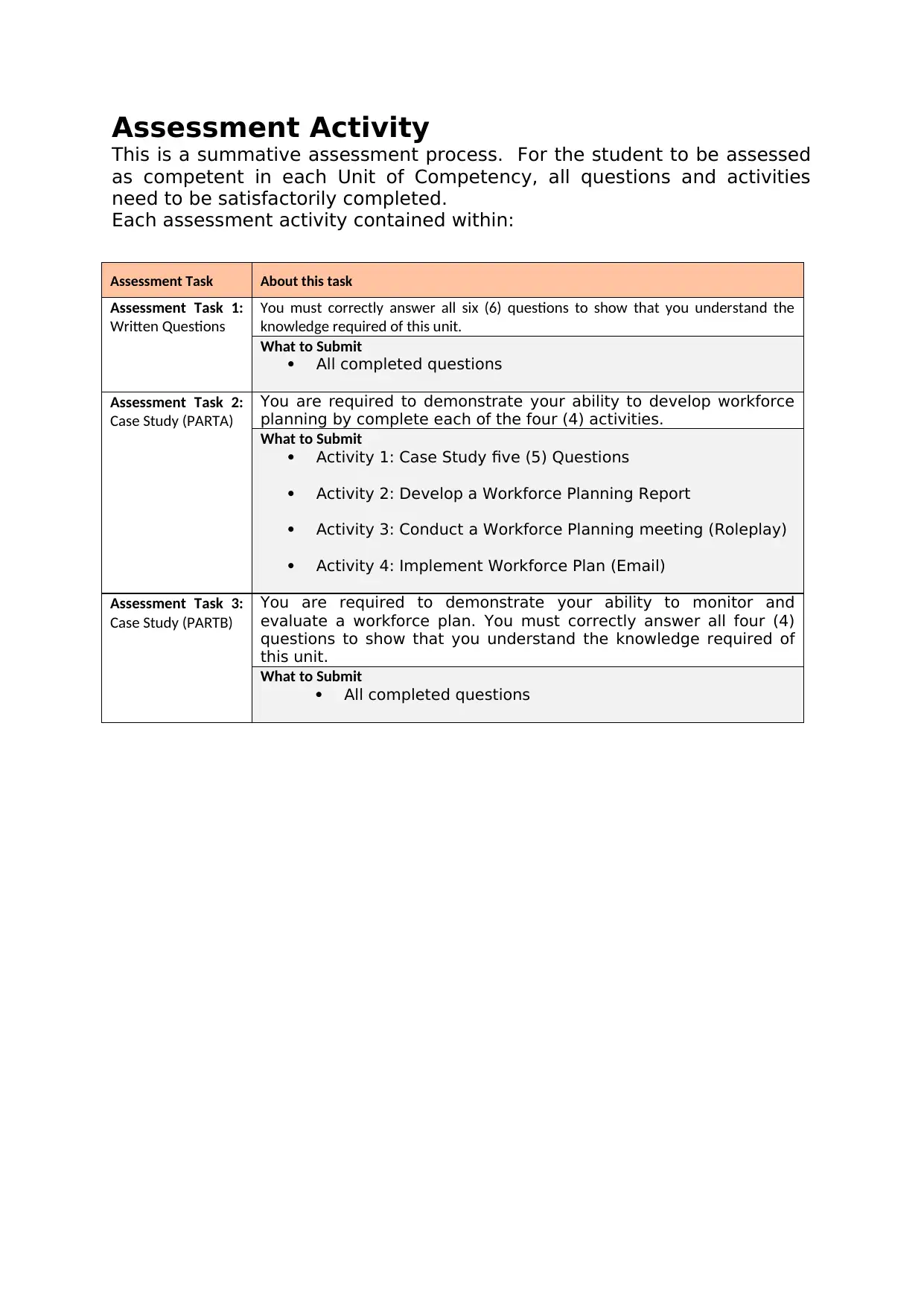
Assessment Activity
This is a summative assessment process. For the student to be assessed
as competent in each Unit of Competency, all questions and activities
need to be satisfactorily completed.
Each assessment activity contained within:
Assessment Task About this task
Assessment Task 1:
Written Questions
You must correctly answer all six (6) questions to show that you understand the
knowledge required of this unit.
What to Submit
All completed questions
Assessment Task 2:
Case Study (PARTA)
You are required to demonstrate your ability to develop workforce
planning by complete each of the four (4) activities.
What to Submit
Activity 1: Case Study five (5) Questions
Activity 2: Develop a Workforce Planning Report
Activity 3: Conduct a Workforce Planning meeting (Roleplay)
Activity 4: Implement Workforce Plan (Email)
Assessment Task 3:
Case Study (PARTB)
You are required to demonstrate your ability to monitor and
evaluate a workforce plan. You must correctly answer all four (4)
questions to show that you understand the knowledge required of
this unit.
What to Submit
All completed questions
This is a summative assessment process. For the student to be assessed
as competent in each Unit of Competency, all questions and activities
need to be satisfactorily completed.
Each assessment activity contained within:
Assessment Task About this task
Assessment Task 1:
Written Questions
You must correctly answer all six (6) questions to show that you understand the
knowledge required of this unit.
What to Submit
All completed questions
Assessment Task 2:
Case Study (PARTA)
You are required to demonstrate your ability to develop workforce
planning by complete each of the four (4) activities.
What to Submit
Activity 1: Case Study five (5) Questions
Activity 2: Develop a Workforce Planning Report
Activity 3: Conduct a Workforce Planning meeting (Roleplay)
Activity 4: Implement Workforce Plan (Email)
Assessment Task 3:
Case Study (PARTB)
You are required to demonstrate your ability to monitor and
evaluate a workforce plan. You must correctly answer all four (4)
questions to show that you understand the knowledge required of
this unit.
What to Submit
All completed questions
⊘ This is a preview!⊘
Do you want full access?
Subscribe today to unlock all pages.

Trusted by 1+ million students worldwide
1 out of 39
Related Documents
Your All-in-One AI-Powered Toolkit for Academic Success.
+13062052269
info@desklib.com
Available 24*7 on WhatsApp / Email
![[object Object]](/_next/static/media/star-bottom.7253800d.svg)
Unlock your academic potential
Copyright © 2020–2025 A2Z Services. All Rights Reserved. Developed and managed by ZUCOL.





